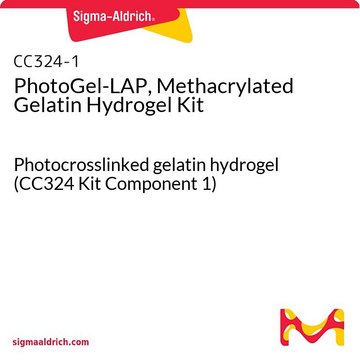927058
TissueFab® bioink kit
(Gel)ma Laminin -UV/365 nm, low endotoxin
Sinônimo(s):
0.2 um sterile filtered, 3D Bioprinting, GelMA, Gelatin methacrylamide, Gelatin methacrylate, Gelatin methacryloyl, Laminin
About This Item
Produtos recomendados
Nível de qualidade
forma
viscous liquid (gel)
Impurezas
<5 CFU/g Bioberden: Aerobic
<5 CFU/g Bioberden: Fungal
<50 EU/mL Endotoxin
cor
pale yellow to colorless
pH
6.5-7.5
viscosidade
3-30 cP
temperatura de armazenamento
−20°C
Procurando produtos similares? Visita Guia de comparação de produtos
Descrição geral
Aplicação
(Gel)ma Laminin -UV/365 nm, low endotoxin features a ready-to-use bioink that is formulated for high cell viability, and printability and is designed for extrusion-based 3D bioprinting and subsequent 365 nm light crosslinking and a solution of Laminin to enhance the bioink. The bioink kit can be used with most extrusion-based bioprinters, are biodegradable, and are compatible with human mesenchymal stem cells (hMSCs) and other diverse cell types. TissueFab®- Low endotoxin GelMA-UV Laminin kit enables the precise fabrication of 3D cell models and tissue constructs for research in 3D cell biology, tissue engineering, in vitro tissue models, and regenerative medicine. Suitable for final Laminin concentrations up to 200ug/ml.
Características e benefícios
Low Endotoxin, low bioburden: Endotoxins have been demonstrated negatively impact cellular growth, morphology, differentiation, inflammation and protein expression. Bioburden is defined as the number of contaminated organisms found in a given amount of material. We test each lot for endotoxins as well as total bioburden (aerobic and fungal) to minimize unwanted interactions. For more information: https://www.sigmaaldrich.com/US/en/technical-documents/technical-article/microbiological-testing/pyrogen-testing/what-is-endotoxin
Informações legais
produto relacionado
Código de classe de armazenamento
10 - Combustible liquids
Escolha uma das versões mais recentes:
Certificados de análise (COA)
Lamentamos, não temos COA para este produto disponíveis online no momento.
Se precisar de ajuda, entre em contato Atendimento ao cliente
Já possui este produto?
Encontre a documentação dos produtos que você adquiriu recentemente na biblioteca de documentos.
Nossa equipe de cientistas tem experiência em todas as áreas de pesquisa, incluindo Life Sciences, ciência de materiais, síntese química, cromatografia, química analítica e muitas outras.
Entre em contato com a assistência técnica





